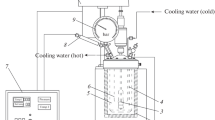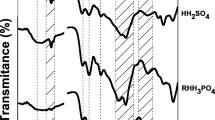Abstract
Hydrothermal carbonization (HTC) of agroforestry biomass involving poplar wood (PW) and corn stalk (CS) was carried out in a multifunction reactor. The effects of reaction temperature, holding time, and initial pressure on the evolution of proximate analysis parameters, element composition, mass yield, energy yield, and major chemical components in both hydrochars were analyzed. The obtained results indicated that hydrothermal carbonization has a significant influence on the fuel properties of hydrochars. The impact of HTC operating parameters is ordered as reaction temperature > > holding time > initial pressure, and high initial pressure is helpful for the acceleration of the reaction rate of the HTC process. As reaction temperature increases from 180 to 260 °C, there is a significant decrease in volatile matter, mass yield, energy yield, atomic ratios of H/C and O/C, and element yield efficiency of hydrochars, but an obvious increase in fixed carbon, higher heating value, and energy enhancement factor of hydrochars. The hemicellulose decomposition coefficients of CS and PW hydrochars reach 62.7–68.4% at 180 °C and gradually stabilize at approximately 93% and 75% while reaction temperature is larger than 220 °C. The corresponding cellulose decomposition coefficients are relatively low at 180 °C, followed by a rapid increase, and achieve the maximum of 92.1–94.2% at 260 °C. The thermal sensitivity of agricultural biomass is stronger than that of forestry biomass as the severity of HTC treatment, and an optimal HTC operation parameter should be adopted to improve fuel performances of agroforestry.
Graphical abstract








Similar content being viewed by others
Abbreviations
- HTC:
-
Hydrothermal carbonization
- PW:
-
Poplar wood
- CS:
-
Corn stalk
- HHV:
-
Higher heating value
- VM:
-
Volatile matter
- FC:
-
Fixed carbon
- M:
-
Moisture
- A:
-
Ash
- NDF:
-
Neutral detergent fiber
- ADF:
-
Acid detergent fiber
- ADL:
-
Acid detergent lignin
- R h :
-
Hemicellulose content, wt%
- R c :
-
Cellulose content, wt%
- R l :
-
Lignin content, wt%
- R e :
-
Extraction content, wt%
- η m :
-
Mass yield, %
- λ HHV :
-
Energy enhancement factor, %
- λ d :
-
Component decomposition coefficient, %
- Δλ :
-
Energy enhancement factor difference
- η e :
-
Energy yield, %
- η r :
-
Relative reduction, %
- η C :
-
Carbon element yield efficiency, %
- η H :
-
Hydrogen element yield efficiency, %
- η O :
-
Oxygen element yield efficiency,
References
Torres-Mayanga PC, Lachos-Perez D, Mudhoo A, Kumar S, Brown AB, Tyufekchiev M, Dragone G, Mussatto SI, Rostagno MA, Timko M, Forster-Carneiro T (2019) Production of biofuel precursors and value-added chemicals from hydrolysates resulting from hydrothermal processing biomass: a review. Biomass Bioenerg 130:25. https://doi.org/10.1016/j.biombioe.2019.105397
Banja M, Sikkema R, Jegard M, Motola V, Dallemand JF (2019) Biomass for energy in the EU - the support framework. Energy Policy 131:215–228. https://doi.org/10.1016/j.enpol.2019.04.038
Kline KL, Msangi S, Dale VH, Woods J, Souza GM, Osseweijer P, Clancy JS, Hilbert JA, Johnson FX, McDonnell PC, Mugera HK (2017) Reconciling food security and bioenergy: priorities for action. GCB Bioenergy 9(3):557–576. https://doi.org/10.1111/gcbb.12366
Zhu X, Liu Y, Qian F, Zhou C, Zhang S, Chen J (2015) Role of hydrochar properties on the porosity of hydrochar-based porous carbon for their sustainable application. Acs Sustainable Chemistry & Engineering 3(5):833–840. https://doi.org/10.1021/acssuschemeng.5b00153
Titirici M-M, White RJ, Falco C, Sevilla M (2012) Black perspectives for a green future: hydrothermal carbons for environment protection and energy storage. Energy Environ Sci 5(5):6796–6822. https://doi.org/10.1039/c2ee21166a
Sharma HK, Xu CB, Qin WS (2019) Biological pretreatment of lignocellulosic biomass for biofuels and bioproducts: an overview. Waste Biomass Valorization 10(2):235–251. https://doi.org/10.1007/s12649-017-0059-y
Correa DF, Beyer HL, Fargione JE, Hill JD, Possingham HP, Thomas-Hall SR, Schenk PM (2019) Towards the implementation of sustainable biofuel production systems. Renew Sust Energ Rev 107:250–263. https://doi.org/10.1016/j.rser.2019.03.005
Kan T, Strezov V, Evans TJ (2016) Lignocellulosic biomass pyrolysis: a review of product properties and effects of pyrolysis parameters. Renew Sust Energ Rev 57:1126–1140. https://doi.org/10.1016/j.rser.2015.12.185
Mathimani T, Mallick N (2019) A review on the hydrothermal processing of microalgal biomass to bio-oil - knowledge gaps and recent advances. J Clean Prod 217:69–84. https://doi.org/10.1016/j.jclepro.2019.01.129
Kruse A, Funke A, Titirici MM (2013) Hydrothermal conversion of biomass to fuels and energetic materials. Curr Opin Chem Biol 17(3):515–521. https://doi.org/10.1016/j.cbpa.2013.05.004
Funke A, Ziegler F (2010) Hydrothermal carbonization of biomass: a summary and discussion of chemical mechanisms for process engineering. Biofuels Bioprod Biorefining 4(2):160–177. https://doi.org/10.1002/bbb.198
Fang J, Zhan L, Ok YS, Gao B (2018) Minireview of potential applications of hydrochar derived from hydrothermal carbonization of biomass. J Ind Eng Chem 57:15–21. https://doi.org/10.1016/j.jiec.2017.08.026
Stemann J, Putschew A, Ziegler F (2013) Hydrothermal carbonization: process water characterization and effects of water recirculation. Bioresour Technol 143:139–146. https://doi.org/10.1016/j.biortech.2013.05.098
Shen YF (2020) A review on hydrothermal carbonization of biomass and plastic wastes to energy products. Biomass Bioenerg 134:18. https://doi.org/10.1016/j.biombioe.2020.105479
Kumar M, Oyedun AO, Kumar A (2018) A review on the current status of various hydrothermal technologies on biomass feedstock. Renew Sust Energ Rev 81:1742–1770. https://doi.org/10.1016/j.rser.2017.05.270
Reza MT, Andert J, Wirth B, Busch D, Pielert J, Lynam JG, Mumme J (2014) Hydrothermal carbonization of biomass for energy and crop production. Applied Bioenergy 1:11–29. https://doi.org/10.2478/apbi-2014-0001
Mazumder S, Saha P, Reza MT (2020) Co-hydrothermal carbonization of coal waste and food waste: fuel characteristics. Biomass Conversion and Biorefinery. https://doi.org/10.1007/s13399-020-00771-5
Heidari M, Dutta A, Acharya B, Mahmud S (2019) A review of the current knowledge and challenges of hydrothermal carbonization for biomass conversion. J Energy Inst 92(6):1779–1799. https://doi.org/10.1016/j.joei.2018.12.003
Dieguez-Alonso A, Funke A, Anca-Couce A, Rombola AG, Ojeda G, Bachmann J, Behrendt F (2018) Towards biochar and hydrochar engineering-influence of process conditions on surface physical and chemical properties, thermal stability, nutrient availability, toxicity and wettability. Energies 11(3):26. https://doi.org/10.3390/en11030496
Wilk M, Magdziarz A, Kalemba-Rec I, Szymańska-Chargot M (2020) Upgrading of green waste into carbon-rich solid biofuel by hydrothermal carbonization: the effect of process parameters on hydrochar derived from acacia. Energy 202:117717. https://doi.org/10.1016/j.energy.2020.117717
Tekin K, Karagoz S (2013) Non-catalytic and catalytic hydrothermal liquefaction of biomass. Res Chem Intermed 39(2):485–498. https://doi.org/10.1007/s11164-012-0572-3
Wang TF, Zhai YB, Zhu Y, Li CT, Zeng GM (2018) A review of the hydrothermal carbonization of biomass waste for hydrochar formation: process conditions, fundamentals, and physicochemical properties. Renew Sust Energ Rev 90:223–247. https://doi.org/10.1016/j.rser.2018.03.071
Bach QV, Skreiberg O (2016) Upgrading biomass fuels via wet torrefaction: a review and comparison with dry torrefaction. Renew Sust Energ Rev 54:665–677. https://doi.org/10.1016/j.rser.2015.10.014
Acharya B, Dutta A, Minaret J (2015) Review on comparative study of dry and wet torrefaction. Sustain Energy Technol Assess 12:26–37. https://doi.org/10.1016/j.seta.2015.08.003
Wang S, Dai G, Yang H, Luo Z (2017) Lignocellulosic biomass pyrolysis mechanism: a state-of-the-art review. Prog Energy Combust Sci 62:33–86. https://doi.org/10.1016/j.pecs.2017.05.004
Wen JL, Sun SL, Yuan TQ, Xu F, Sun RC (2014) Understanding the chemical and structural transformations of lignin macromolecule during torrefaction. Appl Energy 121:1–9. https://doi.org/10.1016/j.apenergy.2014.02.001
Vassilev SV, Baxter D, Andersen LK, Vassileva CG (2013) An overview of the composition and application of biomass ash. Part 1. Phase-mineral and chemical composition and classification, Fuel 105:40–76. https://doi.org/10.1016/j.fuel.2012.09.041
Naderi M, Vesali-Naseh M (2019) Hydrochar-derived fuels from waste walnut shell through hydrothermal carbonization: characterization and effect of processing parameters. Biomass Conversion and Biorefinery 11:1443–1451. https://doi.org/10.1007/s13399-019-00513-2
Sharma HB, Sarmah AK, Dubey B (2020) Hydrothermal carbonization of renewable waste biomass for solid biofuel production: a discussion on process mechanism, the influence of process parameters, environmental performance and fuel properties of hydrochar. Renew Sustain Energy Rev 123:109761. https://doi.org/10.1016/j.rser.2020.109761
Sun X, Atiyeh HK, Li M, Chen Y (2020) Biochar facilitated bioprocessing and biorefinery for productions of biofuel and chemicals: a review. Biores Technol 295:122252. https://doi.org/10.1016/j.biortech.2019.122252
Poomsawat S, Poomsawat W (2021) Analysis of hydrochar fuel characterization and combustion behavior derived from aquatic biomass via hydrothermal carbonization process. Case Studies in Thermal Engineering 27:101255. https://doi.org/10.1016/j.csite.2021.101255
Lynam JG, Reza MT, Yan W, Vásquez VR, Coronella CJ (2015) Hydrothermal carbonization of various lignocellulosic biomass. Biomass Conversion and Biorefinery 5(2):173–181. https://doi.org/10.1007/s13399-014-0137-3
Surendra KC, Ogoshi R, Zaleski HM, Hashimoto AG, Khanal SK (2018) High yielding tropical energy crops for bioenergy production: effects of plant components, harvest years and locations on biomass composition. Bioresour Technol 251:218–229. https://doi.org/10.1016/j.biortech.2017.12.044
Souza EJ, Guim A, Batista AMV, Santos KL, Silva JR, Morais NAP, Mustafa AF (2009) Effects of soybean hulls inclusion on intake, total tract nutrient utilization and ruminal fermentation of goats fed spineless cactus (Opuntia ficus-indica Mill) based diets. Small Rumin Res 85(1):63–69. https://doi.org/10.1016/j.smallrumres.2009.07.008
Bach QV, Tran KQ, Khalil RA, Skreiberg O, Seisenbaeva G (2013) Comparative assessment of wet torrefaction. Energy Fuels 27(11):6743–6753. https://doi.org/10.1021/ef401295w
Yan W, Acharjee TC, Coronella CJ, Vasquez VR (2009) Thermal pretreatment of lignocellulosic biomass. Environ Prog Sustain Energy 28(3):435–440. https://doi.org/10.1002/ep.10385
Khan TA, Saud AS, Jamari SS, Ab Rahim MH, Park JW, Kim HJ (2019) Hydrothermal carbonization of lignocellulosic biomass for carbon rich material preparation: a review. Biomass Bioenerg 130:16. https://doi.org/10.1016/j.biombioe.2019.105384
Kang SM, Li XH, Fan J, Chang J (2012) Characterization of hydrochars produced by hydrothermal carbonization of lignin, cellulose, D-xylose, and wood meal. Ind Eng Chem Res 51(26):9023–9031. https://doi.org/10.1021/ie300565d
Hashaikeh R, Fang Z, Butler IS, Hawari J, Kozinski JA (2007) Hydrothermal dissolution of willow in hot compressed water as a model for biomass conversion. Fuel 86(10–11):1614–1622. https://doi.org/10.1016/j.fuel.2006.11.005
Falco C, Baccile N, Titirici MM (2011) Morphological and structural differences between glucose, cellulose and lignocellulosic biomass derived hydrothermal carbons. Green Chem 13(11):3273–3281. https://doi.org/10.1039/c1gc15742f
Samaksaman U, Pattaraprakorn W, Neramittagapong A, Kanchanatip E (2021) Solid fuel production from macadamia nut shell: effect of hydrothermal carbonization conditions on fuel characteristics. Biomass Conversion and Biorefinery. https://doi.org/10.1007/s13399-021-01330-2
Tekin K, Karagoz S, Bektas S (2014) A review of hydrothermal biomass processing. Renew Sust Energ Rev 40:673–687. https://doi.org/10.1016/j.rser.2014.07.216
Fuertes AB, Arbestain MC, Sevilla M, Macia-Agullo JA, Fiol S, Lopez R, Smernik RJ, Aitkenhead WP, Arce F, Macias F (2010) Chemical and structural properties of carbonaceous products obtained by pyrolysis and hydrothermal carbonisation of corn stover. Aust J Soil Res 48(6–7):618–626. https://doi.org/10.1071/sr10010
Mendoza Martinez CL, Sermyagina E, Saari J, Silva de Jesus M, Cardoso M, Matheus de Almeida G, Vakkilainen E (2021) Hydrothermal carbonization of lignocellulosic agro-forest based biomass residues. Biomass Bioenergy 147:106004. https://doi.org/10.1016/j.biombioe.2021.106004
Hoekman SK, Broch A, Robbins C (2011) Hydrothermal carbonization (HTC) of lignocellulosic biomass. Energy Fuels 25(4):1802–1810. https://doi.org/10.1021/ef101745n
Benavente V, Calabuig E, Fullana A (2015) Upgrading of moist agro-industrial wastes by hydrothermal carbonization. J Anal Appl Pyrolysis 113:89–98. https://doi.org/10.1016/j.jaap.2014.11.004
Mihajlović M, Petrović J, Maletić S, Isakovski MK, Stojanović M, Lopičić Z, Trifunović S (2018) Hydrothermal carbonization of Miscanthus × giganteus: structural and fuel properties of hydrochars and organic profile with the ecotoxicological assessment of the liquid phase. Energy Convers Manage 159:254–263. https://doi.org/10.1016/j.enconman.2018.01.003
Sevilla M, Fuertes AB (2009) The production of carbon materials by hydrothermal carbonization of cellulose. Carbon 47(9):2281–2289. https://doi.org/10.1016/j.carbon.2009.04.026
Bobleter O (1994) Hydrothermal degradation of polymers derived from plants. Prog Polym Sci 19(5):797–841. https://doi.org/10.1016/0079-6700(94)90033-7
Funding
This study was financially supported by the National Natural Science Foundation of China (51476079) and the Natural Science Foundation for Young Scientists of Jiangsu Province (Grant No. BK20190708).
Author information
Authors and Affiliations
Corresponding author
Additional information
Publisher's note
Springer Nature remains neutral with regard to jurisdictional claims in published maps and institutional affiliations.
Rights and permissions
About this article
Cite this article
Zhang, Y., Lu, P., Chen, D. et al. Effect of operation conditions on fuel characteristics of hydrochar via hydrothermal carbonization of agroforestry biomass. Biomass Conv. Bioref. 13, 11891–11903 (2023). https://doi.org/10.1007/s13399-021-02003-w
Received:
Revised:
Accepted:
Published:
Issue Date:
DOI: https://doi.org/10.1007/s13399-021-02003-w




